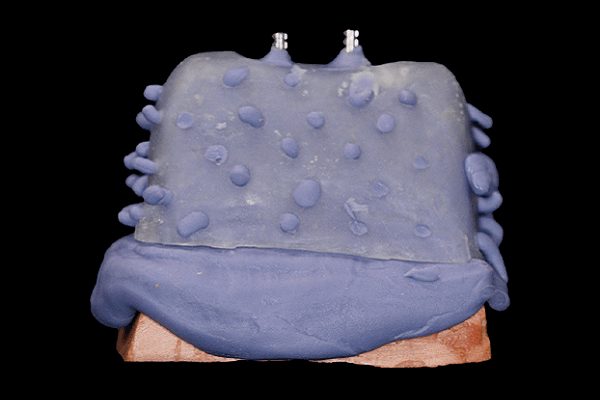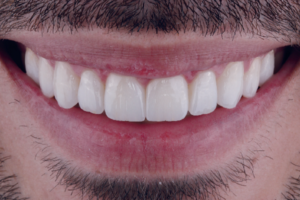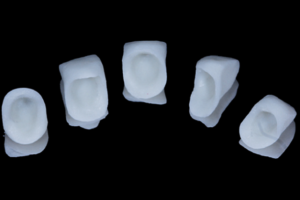RESUMO
Objetivo: avaliar as alterações dimensionais em modelos de gesso obtidos através de moldagens com diferentes técnicas de união dos transferentes quadrados. Métodos: foram confeccionados modelos de gesso obtidos com a técnica de moldagem de arrasto de dois implantes dentários, com a utilização de moldeira aberta e silicone de condensação, variando a união dos transferentes: cinco unidos com fio dental e resina acrílica autopolimerizável; cinco com fio dental e resina acrílica seccionados; cinco com fio ortodôntico e resina acrílica; e cinco sem união dos transferentes. A variação da distorção das moldagens foi analisada por meio de escaneamento dos modelos obtidos, verificando a alteração da distância entre os implantes e a angulação entre eles. Resultados: todos os modelos apresentaram algum grau de distorção, tanto na distância quanto na angulação, contudo o que menos apresentou alterações foi o grupo unido com fio ortodôntico e resina acrílica. Conclusão: a união dos transferentes com fio ortodôntico e resina acrílica é uma técnica clínica simples, gerando boa precisão dimensional.
Palavras-chave – Implantes dentários; Técnica de moldagem odontológica; Materiais para moldagem odontológica; Precisão da medição dimensional.
ABSTRACT
Objective: to evaluate dimensional changes in plaster models obtained through impressions using different techniques for joining square transfers. Methods: plaster models obtained by the drag molding technique of two dental implants were made, using an open tray and condensation silicone, varying the union of the transfers, 5 of which were joined with dental floss and self-polymerizing acrylic resin; 5 with sectioned dental floss and acrylic resin and 5 with orthodontic floss and acrylic resin and 5 without union of the transfers. The variation in distortion of the impressions was analyzed by scanning the models obtained, checking the change in the distance between the implants, as well as the angulation between them. Results: all models showed some degree of distortion, both in distance and angulation, however, the one that showed the least changes was the group united with orthodontic wire and acrylic resin. Conclusion: the union of transfers, for the manufacture of multiple implant prostheses, be carried out with orthodontic wires and acrylic resin, given that this technique was the one that obtained a lower degree of distortion, providing a more precise impression.
Key words – Dental implants; Dental impression technique; Dental impression materials; Accuracy.
Referências
- Nateghi M, Negahdari R, Molaei S, Barzegar A, Bohlouli S. Comparison of the accuracy of fixture-level implant impression making with different splinting techniques. Int J Dent 2021;2021:2959055.
- Silva MM, Mima EGO, Segalla JCM, Silva R, Pinelli LAP. Técnicas de moldagem em prótese sobre implantes. Revista de Odontologia da Unesp 2008;37(4):301-8.
- Pinto JHN, Valle AL, Scolaro JM, Bonfante G, Pegoraro LF. Estudo comparativo entre técnicas de moldagem para implantes odontológicos. Rev Fac Odontol Bauru 2001;9(3/4):167-72.
- Costa MD, Oliveira Neto LA, Ramos MB, Rubo JH. Moldagem de transferência com moldeira aberta para próteses implantossuportadas – relato de caso clínico. Full Dent Sci 2011;2(7):258-64.
- Rutkunas V, Bilius V, Simonaitis T, Auskalnis L, Jurgilevicius J, Akulauskas M. The effect of different implant impression splinting techniques and time on the dimensional accuracy: an in vitro study. J Dent 2022;126:104267.
- Belas A, Tomio R, Silva W. Nova técnica para transferência de implantes múltiplos. ImplantNews 2012;9(6):885-90.
- Parameshwari G, Chittaranjan B, Sudhir N, Anulekha-Avinash C-K, Taruna M, Ramureddy M. Evaluation of accuracy of various impression techniques and impression materials in recording multiple implants placed unilaterally in a partially edentulous mandible – an in vitro study. J Clin Exp Dent 2018;10(4):388.
- Ozan O, Hamis O. Accuracy of different definitive impression techniques with the all-on-4 protocol. J Prosthet Dent 2019;121(6):941-8.
- Liu DY, Cader FN, Abduo J, Palamara J. Accuracy of different implant impression techniques: evaluation of new tray design concept. J Prosthodont 2019;28(2):682-7.
- Papazoglou E, Wee AG, Carr AB, Urban I, Margaritis V. Accuracy of complete-arch implant impression made with occlusal registration material. J Prosthet Dent 2020;123(1):143-8.
- Kaur T, Singla S, Kumar L. Comparison of accuracy of hexed and nonhexed pickup impression copings in a multiple variable impression setup for recording multiple straight and angulated implant positions: an in vitro study. J Indian Prosthodont Soc 2023;23(1):21-9.
- Filho HG, Mazaro JV, Vedovatto E, Assunção WG, dos Santos PH. Accuracy of impression techniques for implants. Part 2 – comparison of splinting techniques. J Prosthodont 2009;18(2):172-6.





